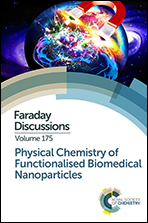Electrochemical Kinetic Fingerprinting of Single-Molecule Cooridations in the Confined Nanopores
IF 3.3
3区 化学
Q2 CHEMISTRY, PHYSICAL
引用次数: 0
Abstract
Metal centers are essential for enzyme catalysis, stabilizing the active site, facilitating electron transfer, and maintaining the structure through coordination with amino acids. In this study, K238H-AeL nanopores with histidine sites were designed for the first time as single-molecule reactors for the measurement of single-molecule coordination reactions. The coordination mechanism of Au(Ⅲ) with histidine and glutamate in nano-confined biological nanopores was explored. Specifically, Au(Ⅲ) interacts with the nitrogen (N) atom in the histidine imidazole ring of the K238C-AeL nanopore and the oxygen (O) atom in glutamate to form a stable K238H-Au-Cl2 complex. The formation mechanism of this complex was further validated through single-molecule nanopore analysis, mass spectrometry, and molecular dynamics simulations. By introducing histidine and glutamic acid into different positions within the nanopore revealed that the formation of the histidine-Au coordination bond in the confined space requires a distance within 2.5 Å between the ligand and the central metal atom. By analyzing the association and dissociation rates of single Au(Ⅲ) ions under the applied voltages, it was found that a confined nanopore increased the bonding rate of Au(Ⅲ)-Histidine coordination reactions by around 105 times compared to the bulk solution, and the optimal voltage for single-molecule coordination., providing valuable insights for designing reaction pathways in electrochemical catalysis. This research revealed a novel mechanism for metal coordination and amino acid residues in protein nanoconfined space, highlighting the dynamic interactions between metal ions and amino acid residues and the importance of the confined effect, providing insights for developing efficient, eco-friendly electrocatalytic nanomaterials.封闭纳米孔中单分子共沉淀的电化学动力学指纹图谱
金属中心对酶催化至关重要,它能稳定活性位点、促进电子转移,并通过与氨基酸的配位维持结构。本研究首次设计了具有组氨酸位点的 K238H-AeL 纳米孔作为单分子反应器,用于测量单分子配位反应。研究探讨了组氨酸和谷氨酸在纳米生物纳米孔中的配位机制。具体而言,金(Ⅲ)与 K238C-AeL 纳米孔中组氨酸咪唑环上的氮(N)原子和谷氨酸中的氧(O)原子相互作用,形成稳定的 K238H-Au-Cl2 复合物。通过单分子纳米孔分析、质谱分析和分子动力学模拟,进一步验证了该复合物的形成机制。通过在纳米孔内的不同位置引入组氨酸和谷氨酸,发现在封闭空间内形成组氨酸-金配位键需要配体与中心金属原子之间的距离在 2.5 Å 以内。通过分析单个 Au(Ⅲ)离子在外加电压下的结合和解离速率,发现与大体积溶液相比,密闭纳米孔提高了 Au(Ⅲ)-组氨酸配位反应的成键速率约 105 倍,并找到了单分子配位的最佳电压,为设计电化学催化反应途径提供了宝贵的启示。该研究揭示了金属配位与氨基酸残基在蛋白质纳米封闭空间中的新机制,突出了金属离子与氨基酸残基之间的动态相互作用以及封闭效应的重要性,为开发高效、环保的电催化纳米材料提供了启示。
本文章由计算机程序翻译,如有差异,请以英文原文为准。
求助全文
约1分钟内获得全文
求助全文
来源期刊

Faraday Discussions
化学-物理化学
自引率
0.00%
发文量
259
期刊介绍:
Discussion summary and research papers from discussion meetings that focus on rapidly developing areas of physical chemistry and its interfaces
 求助内容:
求助内容: 应助结果提醒方式:
应助结果提醒方式:


